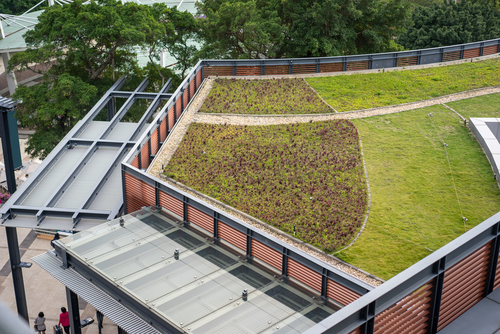When choosing a new roof for your commercial property, you probably have a range of requirements. From thermal efficiency, to structural integrity, a good roof will provide a range of benefits. But with so many different types of roof to choose from, knowing which one to opt for can be a challenge. A blue roof can be a good choice, as can a green roof. But what are the differences between these two commercial roofing options? Which option will be right for your property? Well, here at Enviroply Roofing, we are the North West’s leading roofing professionals. From industrial roofing to schools and commercial properties, we provide a range of high quality, professional roofing solutions, Including both blue roofs, and green roofs. As a result, we have produced this guide comparing blue roofs with green roofs. So which should your company choose?
What is a blue roof?
So, let’s start by looking at the blue roof. What is it and what kind of benefits can you expect? Well, a blue roof is roof that is designed to collect rainwater as it falls, and then release this same rainwater slowly and steadily over a 24-hour period. This can be very helpful in areas where flooding and excess water are an issue.
What is a green roof?
A green roof is a roof that is designed using a single ply roofing system, with a mat of vegetation laid across the top to act as a ballast. This is often a sedum mat, as sedums are a type of hardy plant that can thrive in difficult places, like your roof. This type of roof adds aesthetic value to your property, while also creating a habitat for local wildlife, and improving the quality of the air around your property.
Comparing blue roofs with green roofs
So, if your property is suitable for both a blue roof and a greed roof, which option should you choose? Well, there are some similarities and differences between these two options, including:
- Both of these types of roofs can slow down water release- a blue roof is specifically designed to collect and release water over a 24-hour period. This means that if you live in an area where flood water and high rain fall is a problem, you should opt for a blue roof. However, because of the layer of vegetation on top, a green roof will also collect some rainwater in the soil. This will remain in the soil until utilised by the plants, or evaporation. Once the soil is saturated, it will no longer help to reduce the flow of water. So unlike a blue roof, the water will not be slowly released from a green roof, but less water will end up in sewers and drains, until the soil is saturated.
- Both are good for the environment- a blue roof can be beneficial to the local environment, by reducing the risk and the amount of flooding. At the same time, a green roof creates new habitats for birds and insects in space that would otherwise be barren. So if your company cares for the environment, either of these options could be a good fit.
- Both can cool your building- both a blue roof and a green roof can have a cooling effect on your building, as the roof is protected from the heat of the sun, and is also cooled down by frequent rain. This means you will need to spend less money on cooling your property in the summer months.
For more information or for specific advice regarding your property, get in touch with the experts today, here at Enviroply Roofing.

